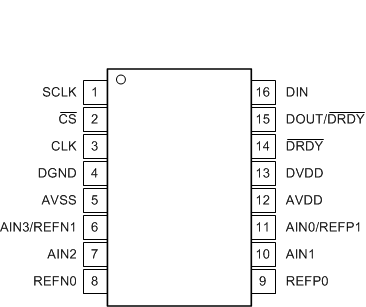SBAS535C August 2013 – February 2017 ADS1120
PRODUCTION DATA.
- 1 Features
- 2 Applications
- 3 Description
- 4 Revision History
- 5 Pin Configuration and Functions
- 6 Specifications
- 7 Parameter Measurement Information
-
8 Detailed Description
- 8.1 Overview
- 8.2 Functional Block Diagram
- 8.3 Feature Description
- 8.4 Device Functional Modes
- 8.5 Programming
- 8.6 Register Map
- 9 Application and Implementation
- 10Power Supply Recommendations
- 11Layout
- 12Device and Documentation Support
- 13Mechanical, Packaging, and Orderable Information
パッケージ・オプション
メカニカル・データ(パッケージ|ピン)
サーマルパッド・メカニカル・データ
- RVA|16
発注情報
5 Pin Configuration and Functions
RVA Package
16-Pin VQFN
Top View

PW Package
16-Pin TSSOP
Top View

Pin Functions
| PIN | ANALOG OR DIGITAL INPUT/OUTPUT |
DESCRIPTION(1) | ||
|---|---|---|---|---|
| NAME | NO. | |||
| RVA | PW | |||
| AIN0/REFP1 | 9 | 11 | Analog input | Analog input 0, positive reference input 1 |
| AIN1 | 8 | 10 | Analog input | Analog input 1 |
| AIN2 | 5 | 7 | Analog input | Analog input 2 |
| AIN3/REFN1 | 4 | 6 | Analog input | Analog input 3, negative reference input 1. Internal low-side power switch connected between AIN3/REFN1 and AVSS. |
| AVDD | 10 | 12 | Analog | Positive analog power supply |
| AVSS | 3 | 5 | Analog | Negative analog power supply |
| CLK | 1 | 3 | Digital input | External clock source pin. Connect to DGND if not used. |
| CS | 16 | 2 | Digital input | Chip select; active low. Connect to DGND if not used. |
| DGND | 2 | 4 | Digital | Digital ground |
| DIN | 14 | 16 | Digital input | Serial data input |
| DOUT/DRDY | 13 | 15 | Digital output | Serial data output combined with data ready; active low |
| DRDY | 12 | 14 | Digital output | Data ready, active low. Leave unconnected or tie to DVDD using a weak pull-up resistor if not used. |
| DVDD | 11 | 13 | Digital | Positive digital power supply |
| REFN0 | 6 | 8 | Analog input | Negative reference input 0 |
| REFP0 | 7 | 9 | Analog input | Positive reference input 0 |
| SCLK | 15 | 1 | Digital input | Serial clock input |
| Thermal pad | — | — | Thermal power pad. Do not connect or only connect to AVSS. | |
(1) See the Unused Inputs and Outputs section for unused pin connections.